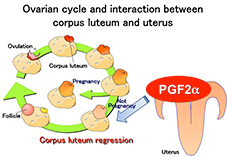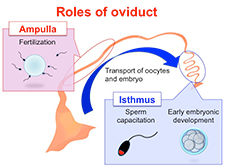Reproductive Physiology
Reproductive Physiology
Staff
 | Prof. Dr. KIMURA Koji E-mail: kimurak@(@okayama-u.ac.jp) Specialty: Reproductive Physiology Establishment of pregnancy in farm animals |
 | Assist. Prof. Dr. YAMAMOTO Yuki E-mail: yyamamoto@(@okayama-u.ac.jp) Specialties: Reproductive Physiology, Reproductive Endocrinology Physiological studies on the regulatory mechanism of reproductive function in mammals |
Research Topics
Reproduction is regulated by many hormones in mammals. Our research is focused on understanding the complex mechanisms regulating the functions of the ovary, endometrium and oviduct in cows and horses. We have a good command of in vitro techniques which allow us to study the regulation of the functions of individual genes involved in the regulation of the reproductive function. The objectives of our research are to enhance the reproductive efficiency of food-producing animals.
Study on the local regulating mechanisms of luteal functions
Corpus luteum: The corpus luteum (CL) is a structure on the ovary which secretes progesterone, a hormone required for normal pregnancy in all mammals. If pregnancy is not established, the CL regresses and disappears from the ovary.
a) Regulatory mechanisms of progesterone production throughout the luteal phase
b) Apoptotic and anti-apoptotic mechanism of luteal cells
c) Effects of cytokines derived from immune cells which migrate into CL before luteolysis
Study on the local regulating mechanisms of endometrial function
|
Endometrium: The mammalian endometrium changes morphologically and functionally throughout the estrous cycle. Prostaglandins (PGs), which relate to establish pregnancy, maternal recognition of pregnancy and implantation and CL regression, are produced by endometrium. |  |
Study on the regulating mechanisms of transport of gametes and embryo in oviduct
|
Oviduct: Oviduct provides the optimal environment for fertilization, early embryonic development and transport of gametes and embryo. Oviductal smooth muscle motility and ciliary beating of epithelial cells are important for the transport of gametes and embryo. |  |
Publication List
- Hashiba K, Sano M, Nio-Kobayashi J, Hojo T, Skarzynski DJ, Okuda K: Galectin-3 contributes to luteolysis by binding to β1 integrin in the bovine corpus luteum. Biol Reprod, 91 (1), 2, 1-10 (2014)
- Abe H, Al-zi'abi MO, Sekizawa F, Acosta TJ, Skarzynski DJ, Okuda K: Lymphatic involvement in the disappearance of steroidogenic cells from the corpus luteum during luteolysis. PLOS ONE, 20; 9 (2): e88953 doi: 10.1371/journal.pone.0088953 (2014)
- Yoshioka S, Abe H, Sakumoto R, Okuda K: Proliferation of luteal steroidogenic cells in cattle. PLOS ONE, doi: 10.1371/journal.pone.0084186 (2013)
- Kobayashi Y, Wakamiya K, Kohka M, Yamamoto Y, Okuda K: Summer heat stress affects prostaglandin synthesis in the bovine oviduct. Reproduction, 146 (2), 103-110 (2013)
- Arai M, Yoshioka S, Tasaki Y, Okuda K: Remodeling of bovine endometrium throughout the estrous cycle. Anim Reprod Sci, 142 (1-2), 1-9 (2013)
- Kawaguchi S, Bowolaksono A, Sakumoto R, Okuda K: Luteoprotective roles of luteinizing hormone are mediated by not only progesterone production but also glucocorticoid conversion in bovine corpus luteum. Mol Reprod Dev, 80 (3), 204-215 (2013)
- Kamemori Y, Wakamiya K, Nishimura N, Hosaka Y, Ohtani S, Okuda K: Expressions of apoptosis-regulating factors in bovine retained placenta. Placenta, 32 (1), 20-26 (2011)